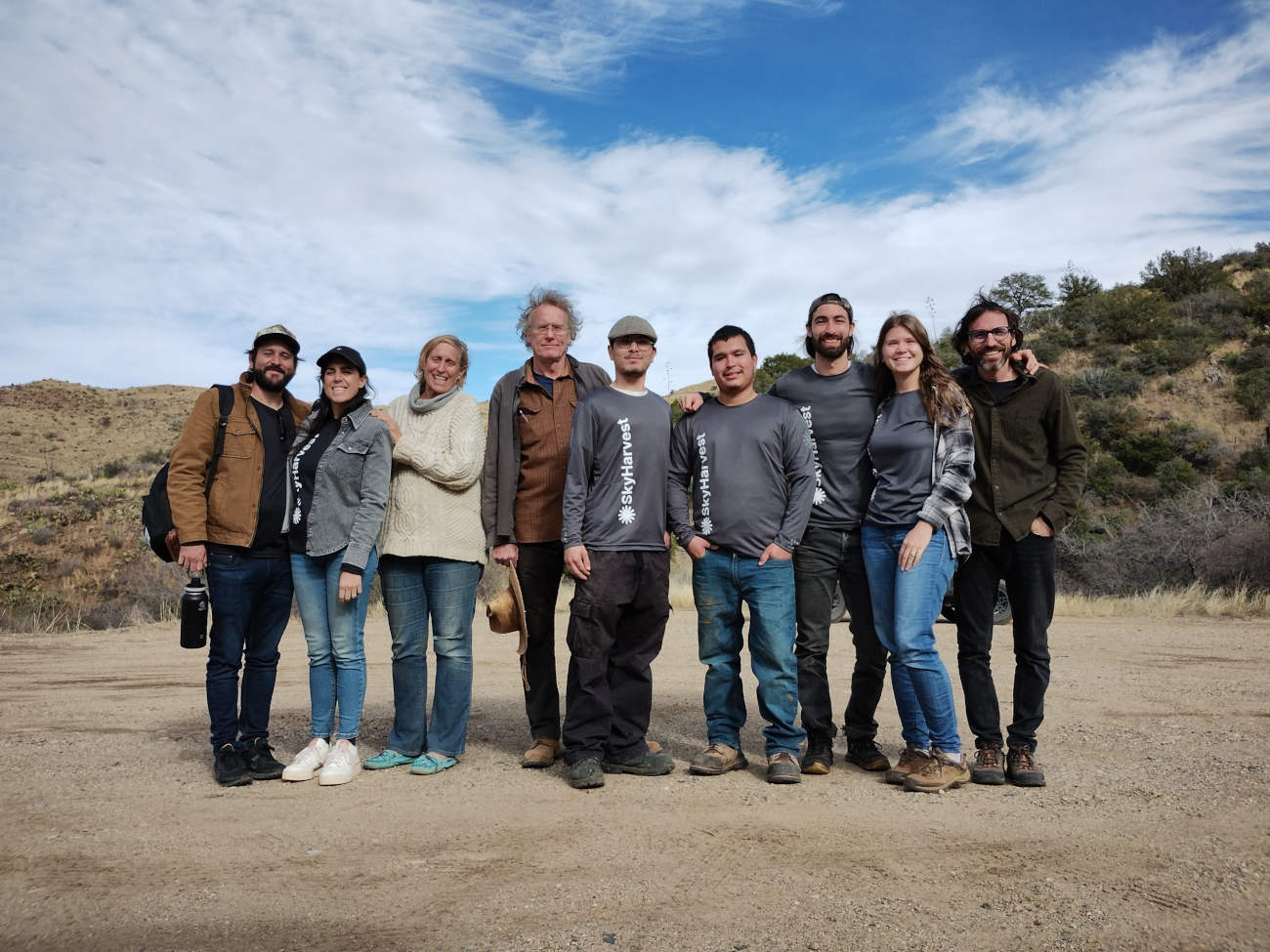Project Overview
Arid lands restoration for healthy animal habitat is a long-term endeavor. Thanks to generous support from Diamond Mountain visitors in November 2021, a vision of land stewardship benefitting animal habitat began strong.
In December 2021, SkyHarvest was created to embark on an ambitious project with $133,000 in funding: plant trees in the desert. Recognizing that trees require water and soil to thrive, an inspired and experienced team was assembled to construct and seed earthworks across the landscape. These earthworks were designed to slow water flow, build soil, and help seeds germinate.


Volunteer Efforts
During two volunteer sessions in 2022, the team created a documentary highlighting their efforts and the global community’s involvement which you can see here:
By March 2023, a smaller team evaluated the progress and planned further ecological restoration, with key participants including Project Manager Kat Ehrhorn and Biochar Consultant Pachi Coquet, Special Coordinator Bob Cirino, volunteer Hannah Cirino, Grant Writer Eunice De Alba and volunteer Rene Anguiano.
Expert training was provided by David Seibert Ph.D., UofA, Wildlife Corridors LLC, Borderlands Restoration Network (BRN) and Josiah Austin, neighbor and globally recognized sustainability rancher.

Progress and Challenges
Over two years, with volunteer efforts and full-time employees, approximately 4,500 basins were constructed, and tens of thousands of seeds were sown. Significant rainfall in 2022 tested the small earthen basins, revealing that stone-reinforced basins were more durable than those basins made without stone.

By early 2023, plant germination was observed, though some dirt basins washed out. Expert consultation indicated that to sustain trees without irrigation, more water in the soil was needed, achievable by slowing down water during rains and accumulating topsoil. Loose rock dams were identified as a key strategy.


Loose Rock Dams and Results
Loose rock dams constructed in sloped washes proved effective in increasing soil water content. A visit to Austin’s property showcased the long-term benefits of these methods, further motivating the team. Please watch this 9-minute video on Austin’s successes, Can Rock Dams Reverse Climate Change? to see the long-term results of what you have helped bring to Diamond Mountain.
Two local young men were employed to construct loose rock dams, in addition to basins while also building the demonstration garden, enhancing the effectiveness of the project.


Project Review
1) Objectives and Achievements
– Design and Construct Earthworks-Based Rainwater Catchment and Retention Methods
– Completed 4,500 basins, 40 loose rock dams and 3 swales.
– Proposed: Continue constructing site-specific earthworks.


2) Restore and Protect Soil Viability
– Mulch and biochar added to demonstration garden and basins.
– Proposed: Continue mulching bare soil around infrastructure.


3) Reseed Native Vegetation Without Irrigation
– Planted 8,000 tree seeds and 30 species of wildflowers, grasses, and shrubs.
– Proposed: Continue seeding efforts.


4) Design and Plant a Demonstration Site
– Installed irrigation, planted 30 trees, created wildlife ponds and 3 swales, and built a trail with interpretive signage, benches and plant identification signage in Apache, Latin and English.
– Proposed: Plant shade vegetation around infrastructure and along trails.


5) Enhance Economic Viability Through Sustainability
– Employed local workers, secured a grant for further restoration, and attracted positive attention from local and international communities. Arid lands restoration has proven to not only be attractive to dharma students and volunteers, but also to institutions, scientists, governments, and activists interested in climate change solutions.
– Proposed: Cultivate and offer ongoing ecological restoration projects to attract positive attention into the future.


Lessons Learned
- Small earthen basins need rock reinforcement to withstand heavy rain.
- Documentation of each basin was impractical; broad-based site changes and yearly photos are more effective.
- Volunteer recruitment was lower than expected; paid local labor proved more cost-effective.
Future Focus
- Site 1 – Maintain the demonstration garden, add mulch, and improve water catchment.
- Site 2 – Continue construction of loose rock dams and smaller earthworks.
- Site 3 – Continue National Fish and Wildlife Foundation grant by building loose rock dams and removing invasive species with $85,000 in contributions of management, volunteer hours, and education until September 2025.
Financial Summary
Total donations from DMRC and individual SkyHarvest donors with restrictions to Bear Springs amounted to $133,424, with $112,997.86 spent in 2021 and 2022 with a mix of volunteer and local labor, and the balance in 2023 continuing work on the demonstration garden, earthworks and seeding in site 2 with local labor.
Please see attached spreadsheet for a detailed presentation of the summarized expenses pie chart.

Summary
Protecting roads, soil and water – contributing to a healthier environment for all – can be achieved through the simple and effective techniques of earthworks and loose rock dams, using biochar, mulch and revegetation.
SkyHarvest sees the potential to collaborate with DMRC on continued ecological restoration priorities enhancing the environment while supporting economic viability and sustainable animal habitat at Bear Springs. This effort will be fostered through grants, corporate donations, and individual contributions, ensuring long-term success.
The following images are a collage of beings at DMRC:













